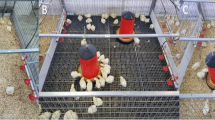Abstract
The need for supplemental heat in brooding chicks in a hot humid tropical area where prevalent mean environmental temperature and relative humidity are 33°C and 60%, respectively, was tested in an experiment using 320 broiler chickens.
The chicks were divided into four quadruplicate lots of 20 birds each and were brooded with or without supplemental heat and light for periods varying between zero and 28 days. Each treatment group of 80 birds was subjected to one of four heat and light treatments, namely: supplementation with heat and light for the 28-day brooding period (control), supplementation with heat and light for the first 14-days only, supplementation for the last 14-days only and non-supplementation with heat and light for the entire 28-day period. Final body weight, body weight gain, feed consumption, feed conversion efficiency and mortality were not significantly (P>0.05) affected by the treatments. However, chicks brooded with supplemental heat and light for 28 days consumed significantly more water than all others. Chicks brooded without supplemental heat and light for 28 days had significantly (P<0.05) higher haemoglobin and hematocrit values than all others.
Similar content being viewed by others
References
DACIE, J. V. and LEWIS, S. M. (1963): Practical Hematology. 3rd ed. London.
DEATON, J. W., REECE, F. N. and VARDAMAN, T. N. (1968): The effect of temperature and density on broiler performance. Poultry Sci. 47: 293–300.
DVORAK, R. A. and BRAY, D. J. (1978): Influence of cellulose and ambient temperature on feed intake and growth of chicks. Poultry Sci. 57: 1351–1354.
OINER, W. P. and HUSTON, T. M. (1957): The influence of high environmental temperature on immature domestic fowl. Poultry Sci. 36: 973–978.
KUBENA, L. F., MAY, J. D., REECE, F. N. and DEATON, J. W. (1972): Hematocrit and Hemoglobin of broilers as influenced by environmental temperature and dietary iron levels. Poultry Sci. 51: 759–763.
MOYE, R. J., WASHBURN, K. W. and HUSTON, T. M. (1969): Effects of environmental temperature on erythrocyte numbers and size. Poultry Sci. 48: 1683–1686.
OSBALDISTON, G. W. and SAINSBURY, D. W. B. (1963): Control of environment in a poultry house part II. Broiler house expt. Vet. Rec. 75: 193.
PERRY, G. C. (1975): How much water do birds drink? Poultry International. Vol. 14(2): 24–28.
SAINSBURY, D. W. B. (1966): Controlled Environment Housing. The practical problem of obtaining the physiological optimum. In: Physiology of the Domestic fowl. P. 242–245. C. Horton-Smith and E. C. Amoroso (eds.). Edinburgh and London.
Author information
Authors and Affiliations
Rights and permissions
About this article
Cite this article
Kese, A.G., Donkoh, A. & Baafi, M.F. Brooding chicks with or without supplemental heat and light. Int J Biometeorol 28, 1–7 (1984). https://doi.org/10.1007/BF02193507
Received:
Issue Date:
DOI: https://doi.org/10.1007/BF02193507



